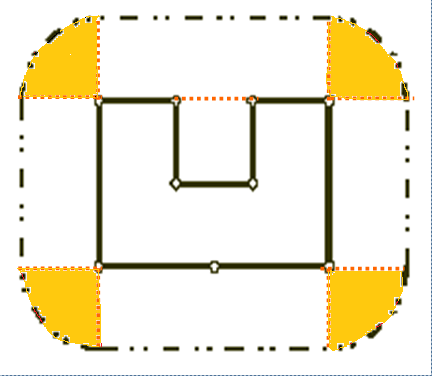题目大意:给N个点,然后要修建一个围墙把所有的点都包裹起来,但是要求围墙距离所有的点的最小距离是L,求出来围墙的长度。
分析:如果没有最小距离这个条件那么很容易看出来是一个凸包,然后在加上一个最小距离L,那么就是在凸包外延伸长度为L,如下图,很明显可以看出来多出来的长度就是半径为L的圆的周长,所以总长度就是凸包的周长+半径为L的圆的周长。

代码如下:
----------------------------------------------------------------------------------------------------------------------------------------------------------------------------------
#include<iostream>
#include<algorithm>
#include<stdio.h>
#include<string.h>
#include<queue>
#include<string>
#include<vector>
#include<math.h>
using namespace std;
const double EPS = 1e-10;
const double PI = acos(-1);
const int MAXN = 1e3+7;
int sta[MAXN], top;
int Sign(double t)
{
if(t > EPS)return 1;
if(fabs(t) < EPS)return 0;
return -1;
}
struct point
{
double x, y;
point(double x=0, double y=0):x(x), y(y){}
point operator - (const point &t)const{
return point(x-t.x, y-t.y);
}
double operator ^(const point &t)const{
return x*t.y - y*t.x;
}
double operator *(const point &t)const{
return x*t.x + y*t.y;
}
}p[MAXN];
double Dist(point a, point b)
{
return sqrt((a-b)*(a-b));
}
bool cmp(point a, point b)
{
int t = Sign((a-p[0])^(b-p[0]));
if(t == 0)
return Dist(a, p[0]) < Dist(b, p[0]);
return t > 0;
}
///求凸包
void Graham(int N)
{///注意是否有1和2的情况,这个题目要求的
sta[0]=0, sta[1]=1, top=1;
for(int i=2; i<N; i++)
{
while(top>0 && Sign((p[i]-p[sta[top]])^(p[sta[top-1]]-p[sta[top]])) <= 0)
top--;
sta[++top] = i;
}
}
int main()
{
int N, L;
while(scanf("%d%d", &N, &L) != EOF)
{
int i, k=0;
for(i=0; i<N; i++)
{
scanf("%lf%lf", &p[i].x, &p[i].y);
if(p[k].y>p[i].y || (p[k].y==p[i].y && p[k].x>p[i].x))
k = i;
}
swap(p[0], p[k]);
sort(p+1, p+N, cmp);
Graham(N);
double ans = Dist(p[sta[0]],p[sta[top]]) + 2*PI*L;
for(int i=0; i<top; i++)
ans += Dist(p[sta[i]], p[sta[i+1]]);
printf("%d
", (int)(ans+0.5));
}
return 0;
}